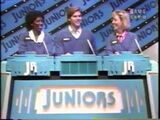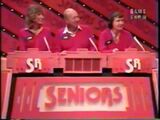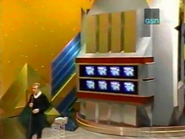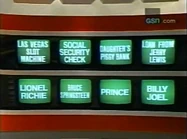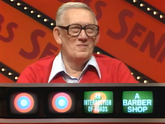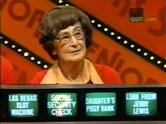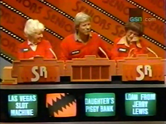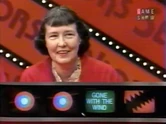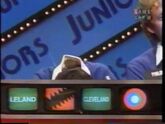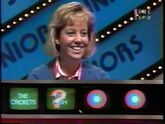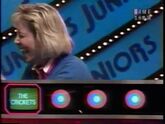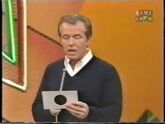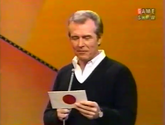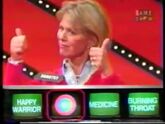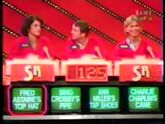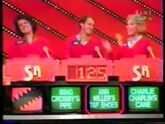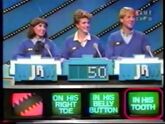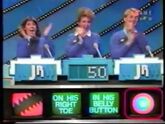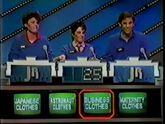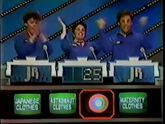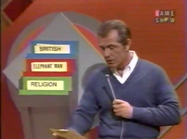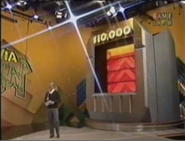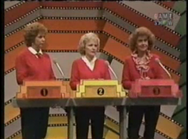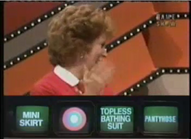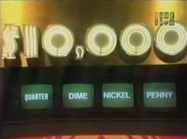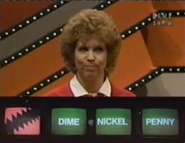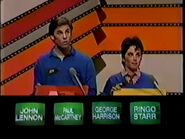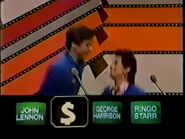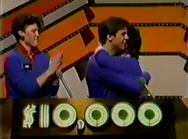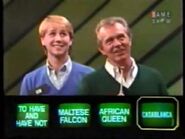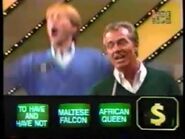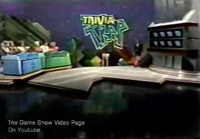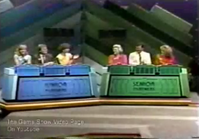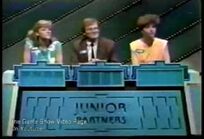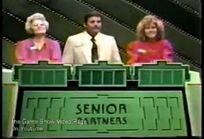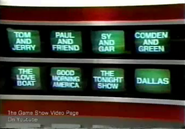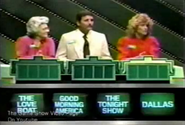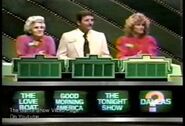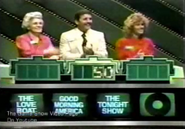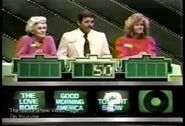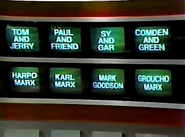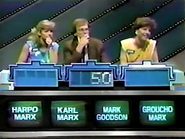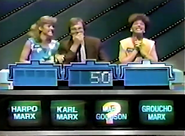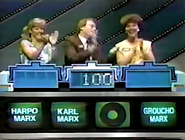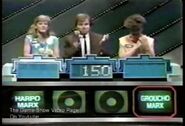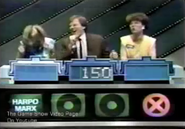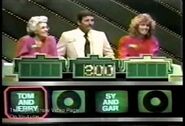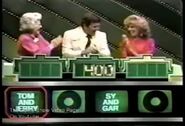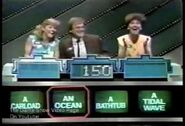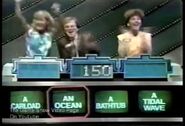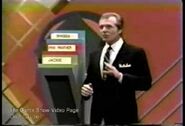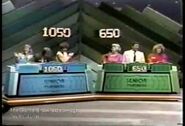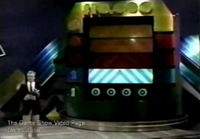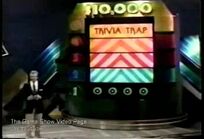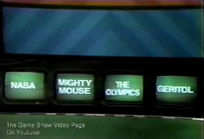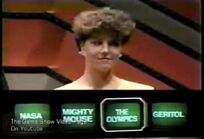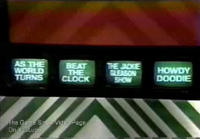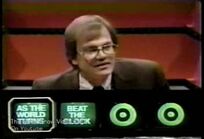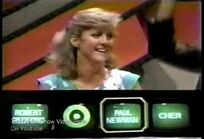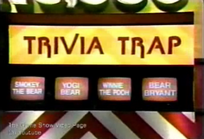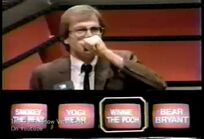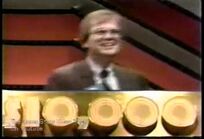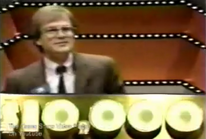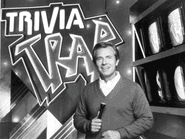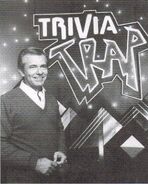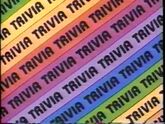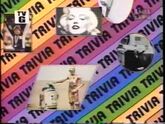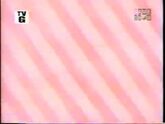| Host | |
| Bob Eubanks | |
| Announcers | |
| Gene Wood (1984, first two weeks) Charlie O'Donnell (1984, third week) Bob Hilton (Pilot and remainder of series) | |
| Broadcast | |
| Pilot: 1984 ABC Daytime: 10/8/1984 – 4/5/1985 | |
| Packager | |
| Mark Goodson Productions | |
PILOT SPIEL: "Here comes the fascinating world of trivia, where even a right answer can catch you in a trap - on Trivia Trap! And our host of Trivia Trap, Bob Eubanks!"
FORMAT #1 SPIEL: "Here comes the fascinating world of trivia, where even a right answer can catch you in a trap - on Trivia Trap! (The Juniors are ready! The Seniors are set to play!) And here's the host of Trivia Trap, Bob Eubanks!"
FORMAT #2 SPIEL: EUBANKS: "Hi, everybody. I'm Bob Eubanks, and I have a trivia question for you: (insert question). We'll find out the answer to this, and many more, on (the all-new edition of)... Trivia Trap!" HILTON: "Welcome to the fascinating world of trivia! Let's meet today's players! Playing for the Seniors today are (insert contestants)! Playing for the Juniors today are (insert contestants)! And here's the host of Trivia Trap, Bob Eubanks!"
REST OF SPIEL: "Thank you. Thank you very much. Hello everybody, and welcome to Trivia Trap, and we're glad you've joined us today. This is the game for those of you who like to know a little bit about everything, and it's played by two opposing teams, and somebody will have a chance to win $10,000."
Trivia Trap was a short-lived show where two teams, one with people under the age of 30 as Juniors and another above the age of 30 being the Seniors and later various celebrities, have to find the right answer in a group of four possible answers to a question by removing all wrong answers.
Gameplay[]
Main Game[]
Two teams of three contestants played. One team was the Juniors, who wore the blue sweaters, and all the contestants were under the age of 30; the other team was the Seniors, who wore the red sweaters, and who were over the age 30. Eubanks always noted that when you have hit your 30th birthday, you're automatically a Senior. These two teams each played games of trivia (whose formats changed as the run went on) to reach a goal of $1,000.
Format #1[]
Teams were shown two rows of monitors, with four answers in each row. The team in control chose one of the two rows, and then a question was asked pertaining to those answers. The team members took turns selecting an answer that they thought was wrong. Upon choosing an answer, a question mark appeared to let the viewers know. When a wrong answer was picked, a bullseye/target appeared; but when the correct answer was chosen, a jaws/teeth/earthquake-like graphic appeared to indicate that the contestant who picked it ran into the “Trivia Trap”. Play continued until all three wrong answers were eliminated, or the correct answer was chosen. The team received $50 for each wrong answer, but for eliminating all three, the value was $300. After one team played their question, a new row replaced the one used, and the second team chose which row to play. Each team played two questions for a possible total of $600.
This format remained in place until December 14, 1984. Mark Goodson decided to rework the format after a focus group from American Film International indicated that the original format of eliminating wrong answers was a gameplay flaw.
Format #2[]
Round 1: Fact or Fiction?[]
Effective December 17, 1984, the front game was changed. The first round was called “Fact or Fiction?” The champions were given the choice of two colored envelopes (Red or Black). Then Bob would ask a True/False question to each contestant, each worth $25. The other team would then play the other envelope. For the second part, the challengers had the choice of envelopes. Each team played two envelopes.
Round 2: The Trivia Trap Round[]
In the second round, the team in the lead (or the champions, in case of a tie) played first and had a choice of two categories. After the category was chosen, four answers were shown. One contestant would answer, and then the other two had a choice to agree or disagree with that answer. Whether the players agreed or disagreed determined the value of a correct answer. If all of them agreed and the answer was right, they would win $200. If one agreed and it was correct, they won won $100. If everybody disagreed it would be worth $50. If they disagreed correctly, they would then be able to choose the correct answer, in the same way explained above. As before, the other player could disagree to try to save the team. After the question, the other team played the other category. Again, each team played two questions.
This second format retained the original Trivia Race format in Round 2, played after the Trivia Trap round.
$1,000 Trivia Race[]
In the final round, known as the $1,000 Trivia Race, control began with the team in the lead; in case of a tie, control began with the champions or the winners of a coin toss. Three categories were shown, and the team in control of the board chose which category they wanted. After a category was used once, a new one replaced it. Bob would read the question, and one at a time, the contestants would answer. If one of them answered correctly, the team kept control and chose another category. $100 was awarded for each correct answer; starting in the show's second week, $200 was awarded for each correct answer after the tenth question (15th question from February 4 – February 6, 1985). If none of the contestants answered correctly, the other team would get control. The first team to reach the goal of $1,000 won the game and went on to play for a possible $10,000.
There were 10 categories in each colored slots making a grand total of 30 categories. It is unknown what happened if nobody reached $1,000 after all the categories had been played.
Bonus Round: "$10,000 Pot of Gold Trivia Ladder"[]
Both formats of the show used the same bonus round, called the $10,000 Pot of Gold Trivia Ladder. This time, the contestants on the winning team played for themselves. The three players played in order by their success in the Trivia Race. A row of monitors rose to the first level of the Trivia Ladder. Four answers were shown to the best contestant. That contestant could then play that question or pass it to the next contestant, who, in turn, could either play that question or pass it to the last one. If a contestant answered correctly, s/he won $1,000. If the contestant answered incorrectly, that player was eliminated, but did return to play the next day.
After the first question was asked, the row of monitors rose to the next level of the ladder, and four new answers were shown to the better-ranked contestant of those remaining. As before, that contestant could either answer or pass to the last player. For the third question, the remaining contestant had to answer.
Any player who answered a question correctly on a lower rung of the ladder played for $10,000. Four answers were shown as before, and a question was asked. The contestants locked in the answer they believed was correct on a hidden panel in their podium. (If only one contestant was playing for the $10,000, that contestant simply said which answer s/he believed was correct.) When the final correct answer was chosen, a $/dollar sign appeared. Any contestant who correctly answered the question won $10,000. If more than one contestant gave the correct answer on the final question, they shared the $10,000. Any team that played The Trivia Ladder five times would retire undefeated; the theoretical total was at least $70,000, with the highest total awarded being $65,500.
Pilot[]
The pilot had basically the same format as the first one in the series, but with several differences in game play. The most obvious differences were that the set was different, and that nobody wore sweaters whatsoever. Also, the Seniors played green instead of red; the Juniors' team color remained the same. Plus the turntable with all three game boards did not turn on camera.
Trivia Trap Round[]
The team in control still cut out wrong answers, but they did that optionally (this was classified as "playing it safe"). The generic purpose for the team was to simply choose the right answer (classified as "going for it"). In the event that the first two contestants played it safe and successfully found the wrong answers, the third contestant was forced to go for it and find the right answer. Choosing incorrect answers were still worth $50, and finding the correct answer was worth double or $100, for a grand total of $200 each turn. If at any time any contestant on the controlling team made a mistake, the money (depending on the criteria) went to the opposing team. Each team had three turns; as in the series each team could earn up to $600.
Trivia Race[]
Trivia Ladder[]
The Trivia Ladder round was played mostly the same, except for the following differences:
- The contestants on the winning team were not positioned according to how successful they were in the Trivia Race; they were positioned by random draw.
- There was no option to play or pass any question. Everybody had to play the answers he/she was on.
- The premise for the first three rungs was the same as the series' first Trivia Trap round, for each contestant had to eliminate all wrong answers on each level. The first incorrect answer was worth $100, the second was worth $500, and all three gave the contestant $1,000 plus the right to play for $10,000 at the top.
- Though the rules for the top were the same, the answers appeared in a red background (generally, the answers appeared on a green background).
Gallery[]
Intro Pictures[]
Rating[]
Music[]
Main by Edd Kalehoff
The last few bars of Family Feud's main theme "The Feud" by Walt Levinsky were used as a win fanfare; those same bars are also used to introduce the Grand Game every time it appears on The Price Is Right.
Tagline[]
"This is Bob Hilton speaking for Trivia Trap, a Mark Goodson Television Production." - Bob Hilton
"This is Trivia Trap, a Mark Goodson Television Production." - Charlie O'Donnell
"This is Bob Hilton speaking for all the real nice folks here at Trivia Trap, a Mark Goodson Television Production." - Bob Hilton (Series Finale)
Inventor[]
Studio[]
ABC Television Center, Hollywood, CA
Trivia[]
- This was the last Goodson show that was an original idea and not a revival of a previous format (barring Lottery game shows).
- During the first format after the first round, host Bob used the unused question with the unused row of answers as a home viewer question. The answer to that question was revealed after the show returned from a commercial break.
- The sound used to reveal the four choices to a question was later recycled as the "Fast Money" answer reveal sound on Family Feud starting with the 1988 revival hosted by the late Ray Combs and all other previous incarnations had it since then.
- The sound used when a wrong answer is eliminated & when the correct home viewer answer was revealed was later recycled into Classic Concentration when a panel flipped. It is also used in numerous Saturday Night Live (SNL) game show skits as a ring-in sound.
- The "trap" sound was recycled into Illinois Instant Riches and Illinois' Luckiest when someone wipes out, as well as The Price is Right for stepping to a wrong number in the Pathfinder game and on NY Wired on occasion. It was also used on the Goodson produced unsold pilot On a Roll when a contestant guesses one of the three-lined puzzles incorrectly.
- The electronic beeps and sirens were used (similar to The Price is Right Clangs and Whoops) when any players who correctly answered the final question, won the entire $10,000 grand prize or if more than one player who gave the correct answer on the final question, these players equally shared the $10,000 grand prize.
- This was the first of two game shows Bob Eubanks hosted for Mark Goodson; the second show he hosted for Goodson was the 1986 revival of Card Sharks for CBS. This was also the last game show Eubanks hosted for ABC after 18¾ years with the network.
- After cancellation, Trivia Trap was replaced the following Monday by the Heatter-Quigley produced show All Star Blitz (which was cancelled in that same year).
- In 2015, Trivia Trap was one of the six potential candidates for Buzzr's "Pick & Play" Sunday Night Lineup block along with Sale of the Century (Perry), Now You See It (Narz), Double Dare (Trebek), Beat the Clock (Hall) and Wordplay (Kennedy). However, along with Now You See It and Wordplay it failed to generate enough votes from the viewers to make it onto the schedule. The block itself consisted of Sale of the Century, Double Dare and Beat the Clock. However, it made it to the Sunday night block two years later knocking out Double Dare.
Links[]
Screengrabs of Trivia Trap
Rules for Trivia Trap @ Jay's Game Show Page
Rules for Trivia Trap @ The Gameshow Galaxy
Rules for Trivia Trap @ The Game Show Temple
A blog about "Trivia Trap"


